How To Find Charge Using Coulomb's Law
In this lecture we will acquire about Coulomb's Law and we will accept a wait at some elementary examples. You tin can watch the following video or read the written tutorial below.
This constabulary was offset defined by French physicist Charles Augustin de Coulomb in 1785 and was essential to the development of the theory of electromagnetism.
Definition of Coulomb'southward Police
Coulomb's Constabulary is a law of physics that describes the interaction between electrically charged objects. It quantifies the amount of electrostatic force that two charged objects exert on each other, which causes an attraction or repulsion between them.
Similar charges, for example ii positive or two negative charges will repel i another, and unlike charges, 1 positive and i negative charge will attract one another because of the electrostatic force.
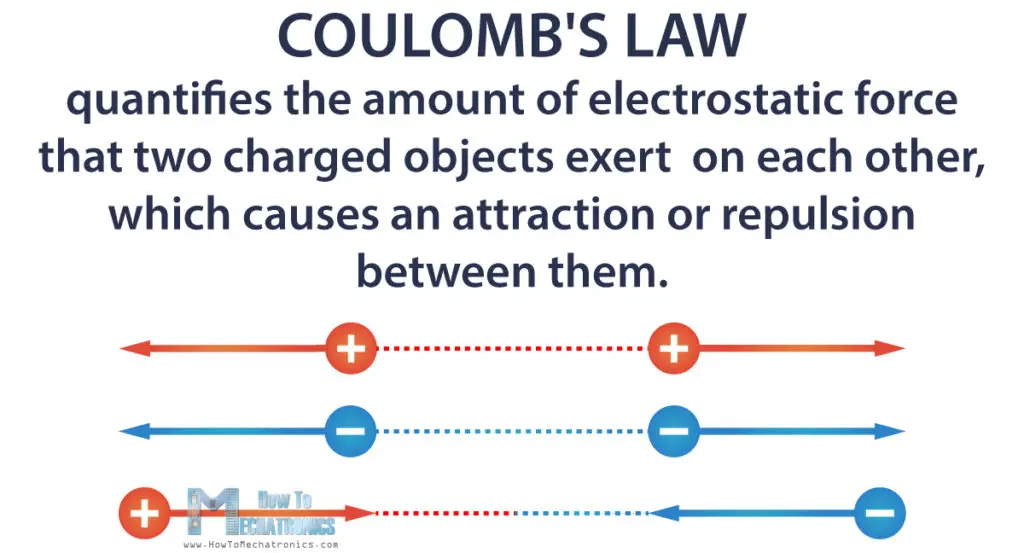
Specifically, this law applies to indicate charges. Any objects can be treated as bespeak charges, equally long as they are very small compared to the altitude betwixt them.
Besides, the force is along the straight line joining those charges.
Coulomb'due south Police force Formula
We already know how to measure out electrical charge. This can help usa calculate the electric force between charged objects.

So, the equation shows that the magnitude of the electric forcefulness between 2 charged particles F is equal to the product of the 2 charges Q1 and Qtwo, divided past the square of the distance between them r, and all that multiplied past the proportionality constant yard.
The electrical force is expressed using the unit Newton.
The reason why the distance is squared is because when the distance betwixt objects doubles, the force between them reduces to a quarter of the original value.
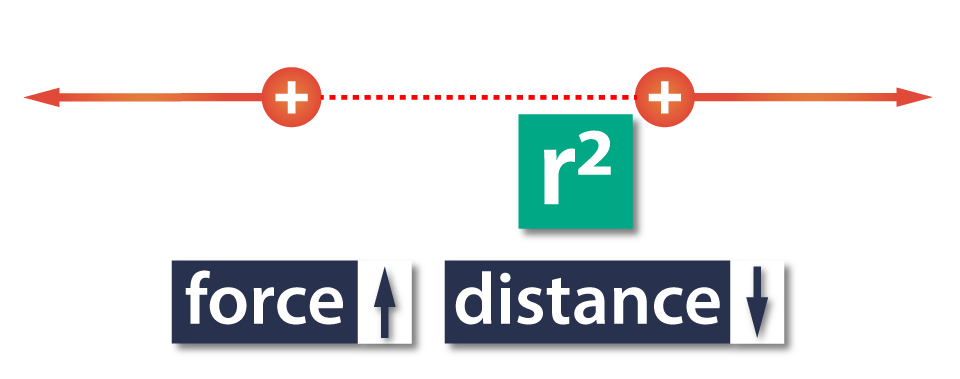
In other words, the electric forcefulness betwixt two objects increases as the altitude between them decreases, and opposite, the force decreases as the distance increases.
The lower-case k is called proportionality constant, or Coulomb's Law constant. The value of this constant is dependent upon the medium in which the 2 objects reside. In this instance the medium is air.
ε0 is called dielectric constant or vacuum permittivity.
Coulomb'southward Police force vs Universal Law of Gravitation
If nosotros compare Coulomb's Police to the Universal Police force of Gravitation, we can notice that they accept some similarities, only they piece of work in completely different ways.
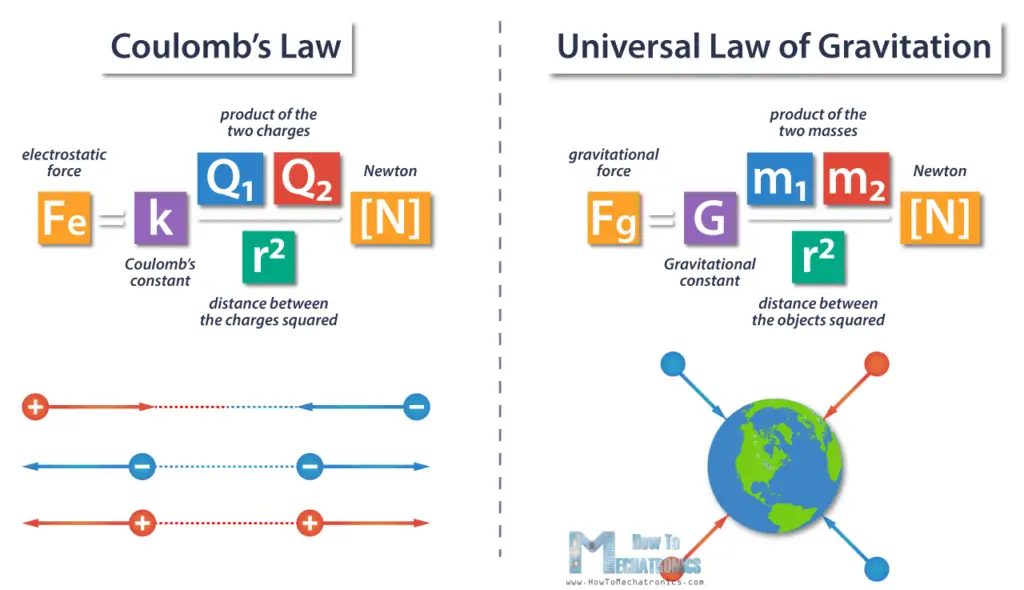
- The electric strength is much stronger than gravity.
- From the equations we can notice that they accept dissimilar proportionality constants.
- In the equation for gravity, we're using mass to find the force, but in the Coulomb'due south Law equation, we're using charge to find the force.
- Thus, the gravitational force is always attractive, depending on the mass of the objects which is ever positive, and on the other side, electrostatic forces can be either attractive or repulsive, depending on the charges, then the upshot can be negative or positive, respectively.
To sum upward, Coulomb's law states:
- Outset, the force between ii similar point charges is repulsive, and between ii different indicate charges is attractive;
- Second, the strength direction is determined by the line that passes through both charges;
- Third, the magnitude of the force is directly proportional to the product of the two charges, and inversely proportional to the square of the altitude betwixt the charges.
Electrostatic Force as a Vector Quantity
Existence a strength, the strength of the electric interaction is a vector quantity that has both magnitude and direction. This means that we can calculate the magnitude and the direction of the electric force based on the sign of the event.
Let's change the equation.
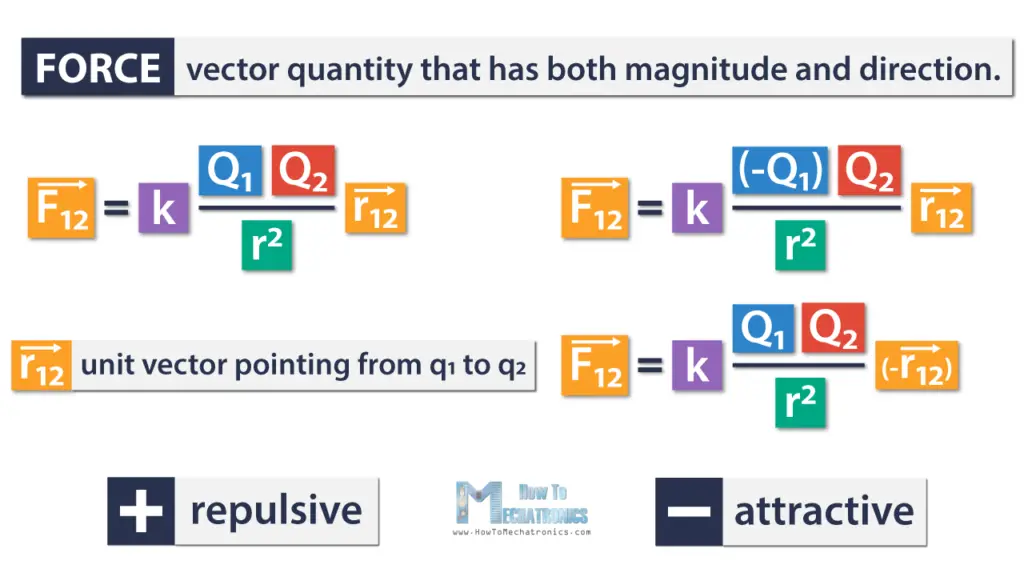
The arrows in the equation stand for a vector quantity.
This is a unit vector pointing from Qi to Q2,and the index 12 means that Q1 exerts force onto q2.
If we get a positive value, information technology means that the management of the force is repulsive. On the other side, the minus sign means that the direction of the force is reverse, or bonny.
Example
Permit's say, we have two positive charges. The first accuse Q1 is 2×10-2 C, and the other accuse Q2 is one×10-3C. The distance betwixt them r is 1mm, which is one×10-3m. Now, we can calculate the forcefulness betwixt these charges using the equation.
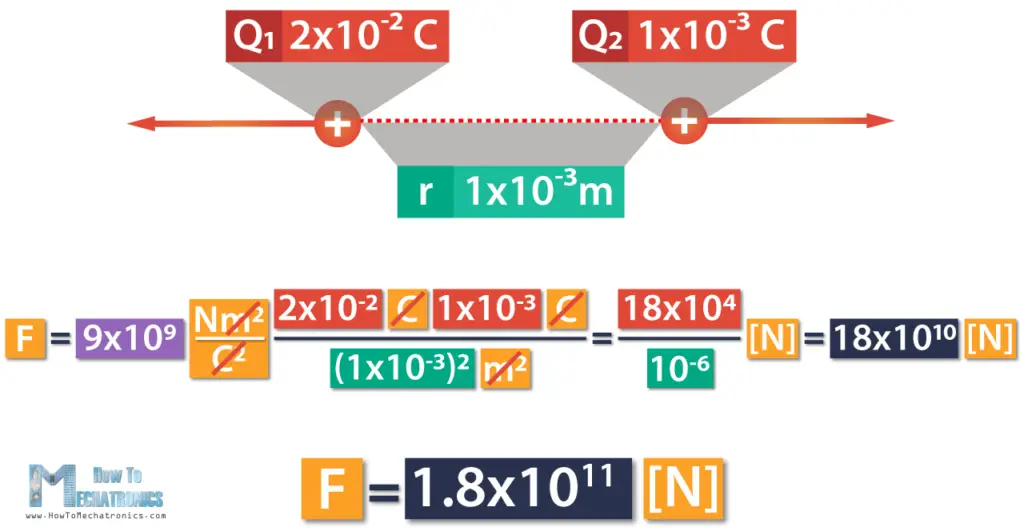
Here we can cancel out meters and Coulombs, which ways we're left with Newtons.
This is equal to xviii×10four divided by x-6, which is xviii×xx.
Finally, the forcefulness is ane.eight×1011 Newtons.
We got a positive issue, meaning that the charges repel i some other. In example we had one positive and one negative charge, we'd get a negative result, which ways they'd concenter i some other.
Superposition Principle
If in that location are multiple point charges, permit's say three, we tin calculate the forcefulness of the 2 charges that acts on the tertiary charge.
This leads the states to the superposition principle which states that for all linear forces the total force is a vector sum of individual forces. This allows Coulomb's law to be extended to include whatever number of betoken charges.
In other words, the total Coulomb force from a organization of point charges acting on a point accuse, can be found by adding upwardly the forces from each of the other individual charges.
Example
We accept three point charges Q1, Q2, and Q, and nosotros need to detect the force that Q1 and Q2 exert on Q. Q and Q1 are positive charges, and Q2 is negative accuse. The force that Q1 applies on Q, Fane is repulsive, and the force that Q2 applies on Q, F2, is attractive.

The total electric force F is a sum of the ii forces F1 and F2, and is represented with this vector F1+F2.
That's all for this tutorial. I hope it was helpful and you learned something new. In the next Bones Electronics tutorial nosotros will talk about Electric Fields.
Source: https://howtomechatronics.com/learn/electricity/coulombs-law/
Posted by: devinemarisch.blogspot.com


0 Response to "How To Find Charge Using Coulomb's Law"
Post a Comment